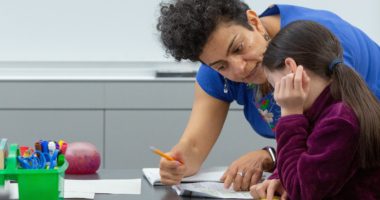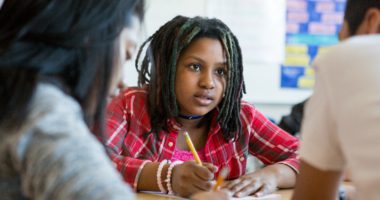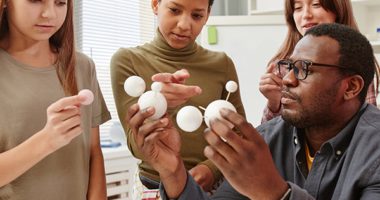District-Nonprofit STEM Partnership Challenges Maryland Middle Schoolers to Invent A More Diverse Future
In a region populated with aerospace and biohealth employers, Montgomery County Public Schools (MCPS) observed some years ago that lower-income Black and Latino students were not enrolling in the Maryland district’s rich array of STEM electives in the same proportion as their White and more affluent peers. The disparity exemplified a stubborn inequity in America’s middle grades, which perpetuates in high school, college and the workforce: lower participation in rigorous, experiential STEM opportunities by students from lower-income households and students of color. A May 2023 Education Trust policy brief highlighted this under-enrollment in middle school and contains recommendations for improving access.
One component of MCPS’s district-wide strategy to promote STEM equity and recover from the COVID-19 pandemic is a partnership with the nonprofit I founded and lead, KID Museum. KID is a hub for hands-on learning centered at a 28,000 sq. ft. educational makerspace in Bethesda, Maryland. In MCPS middle schools, the partnership’s signature program is Invent the Future, a deep-dive learning experience that challenges students in grades 6-8 to work in teams and answer the question, “What will you make to improve life on this planet?”
While developing solutions for problems locally and globally, students problem-solve together as they develop, design and refine their inventions. Started in 2017, following a pilot in one and then seven local schools, the program is now in place at more than 20 MCPS middle schools, most of which have high rates of poverty and Black and Latino students. Nearly 2,000 middle schoolers participated in Invent the Future as a course or afterschool club during the 2022-23 school year.
The design of Invent the Future in the nation’s 14th-largest school district, and its success in boosting students’ STEM interest and confidence, affirms several of Ed Trust’s policy recommendations:
- Invent the Future is open to all. There are no prerequisites or tracks toward enrollment, and students’ elective options are widely publicized to families. KID Museum encourages our school partners to recruit students who may not be the typical “STEM kids.” In some participating middle schools, the program has expanded to all three grades, so any student can enroll regardless of which grade they enter the school. Overall, more than 8 in 10 Invent the Future participants are students of color or multiracial, and more than half qualify for free meals at school.
- KID Museum’s partnership with MCPS provides high-quality instructional materials for classrooms. The Invent the Future course curriculum entails at least 55 hours of hands-on STEM learning per student, including four visits to KID Museum to learn maker skills and work on the team project.
- KID provides professional development for teachers. In fact, this summer, we are launching a yearlong fellowship to build K-8 teachers’ skills and confidence in maker learning, particularly for Maryland educators who work with populations that are under-represented in STEM fields.
- There is infrastructure to support students’ interests. Most schools can’t devote thousands of square feet to a makerspace, but by partnering with KID Museum, MCPS schools have access to the nation’s leading center for maker learning — and our 3D printers, power drills, scroll saws, microcontrollers and computers for coding, and motors, sensors and buzzers for building with electronics. (We’re also well-stocked with cardboard, pipe cleaners and glue guns.) Students are only limited by their imaginations and time.
- Invent the Future is relevant to middle schoolers’ lives, by design. There is no menu of societal problems from which students must choose. Participants pursue what interests their team, as illustrated in a recent Washington Post feature article showcasing MCPS students’ projects. In June, teams presented their inventions at the biomedical sciences and engineering building of the Universities at Shady Grove, a location strategically selected to expose the students to a college campus and its STEM labs. Award-winning creations at the culminating celebration included a dog-walking robot to help elderly pet owners, shoes with trackers to prevent child abductions, a robot that inspects train tracks for potential problems, an e-waste sorter that attaches to garbage trucks, and “a cow fart converter” that converts methane into clean energy.
In Ed Trust’s policy brief, senior analyst Kristen Hengtgen writes, “STEM shouldn’t be a gatekeeper, but rather a door opener.” That’s precisely what we see at KID Museum, and it is most rewarding. Invent the Future’s impact surveys find that students increasingly see themselves as scientists and engineers after participating in the program. Teachers overwhelmingly report increases in their students’ skills and confidence in engineering and technology skills, critical thinking and perseverance.
It’s the process, not just the product, that makes Invent the Future so meaningful for kids. (See the video below.) Through the challenge question, students think creatively, argue about their ideas, compromise, refine their designs through trial and error, apply math, science and other skills from their core classes, and learn to work together. Those are all great skills for their futures – and reassurance for adults that the world will be in good hands.
Cara Lesser is founder and executive director of KID Museum in Bethesda, Maryland, the nation’s leading center for maker learning











